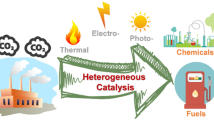Abstract
The practical and theoretical aspects of the conversion of sulfur-containing components during the hydroconversion of heavy oil feedstock in the presence of nanosized MoS2-based catalytic systems are considered. Thermodynamic calculation of the temperature dependences of the equilibrium composition of the products of hydrogenation reactions of sulfur-containing compounds demonstrated that thiophene is the most stable product in a wide temperature range. Quantum-chemical techniques have shown that chemisorption of a hydrogen molecule on valence-unsaturated Mo atoms brings about the breaking of the H–H bond, migration of H atoms to other valence-unsaturated Mo atoms, as well as to S atoms. The study of the interaction of the Н2S molecule with the Mo2S4 and Mo3S6 clusters showed that the chemisorption of Н2S occurs on the valence unsaturated Mo atoms, followed by the abstraction and migration of the Н atoms over the cluster surface, and the unsaturated S atom plays the role of a donor, hydrogen carrier. It was shown that sulfur-containing compounds (mercaptans, thiophene, and dibenzothiophene) are also chemisorbed through S atoms on valence-unsaturated Mo atoms located on the faces of MoS2 clusters.







Similar content being viewed by others
Change history
19 July 2021
An Erratum to this paper has been published: https://doi.org/10.1134/S1070427221050190
REFERENCES
Khadzhiev, S.N., Kadiev, Kh.M., Kadieva, M.Kh., Petrol. Chem., 2014, vol. 54, no. 5, pp. 323–346. https://doi.org/10.1134/S0965544114050065
Khadzhiev, S.N., Kadiev, Kh.M., Yampolskaya, G.P., and Kadieva, M.Kh., Adv. Colloid Interface Sci., 2013, vol. 197–198, pp. 132–145. https://doi.org/10.1016/j.cis.2013.05.003
Kadiev, Kh.M., Khadzhiev, S.N., and Kadieva, M.Kh., Petrol. Chem., 2013, vol. 53, no. 5, pp. 298–308. https://doi.org/10.1134/S0965544113050034
Tomina, N.N., Pimerzin, A.A., and Moiseev, I.K., Ros. khim. zhurn., 2008, vol. LII, no. 4, pp. 41–52.
Nikul'shin, P.A., Tomina, N.N., and Pimerzin, A.A., Izv. vuzov. Khimiya i khim. tekhnologiya, 2007, vol. 50, no. 9, pp. 54–57.
Krebs, E., Daudin, A., and Raybaud, P., Oil Gas Sci. Technol., 2009, vol. 64, no. 6, pp. 707–718. https://doi.org/10.2516/ogst/2009004
Nikul’shin, P.A., Eremina, Yu.V., Tomina, N.N., and Pimerzin, A.A., Petrol. Chem., 2006, vol. 46, no. 5, pp. 343–348. https://doi.org/10.1134/S0965544106050070
Butyrskaya, E.V. and Nechaeva, L.S., Komp'yuternaya khimiya (Computer Chemistry), Voronezh: Izd.-poligraf. tsentr Voronezh. Gos. Univ, 2011.
Tsirel’son, V.G., Kvantovaya khimiya molekuly, molekulyarnye sistemy i tverdye tela (Quantum Chemistry Molecules, Molecular Systems and Solids), Moscow: BINOM. Laboratoriya znanii, 2010.
http://www.hsc-chemistry.net/sait programmnogo paketa HSC Chemistry, 2020.
Breysse, M., Djega-Mariadassou, G., Pessayre, S., Geantet, C., Vrinat, M., Perot, G., and Lemaire, M., Catal. Today, 2003, vol. 84, pp. 129–138. https://doi.org/10.1016/S0920-5861(03)00266-9
Kalechits, I.V., Khimiya gidrogenizatsionnykh protsessov v pererabotke topliv (Chemistry of Hydrogenation Processes in Fuel Processing), Moscow: Khimiya, 1973, pp. 240–255.
Qing, T. and Deen, J., Chem. Mater., 2015, vol. 27, pp. 3743–3748. https://doi.org/10.1021/acs.chemmater.5b00986
Khadzhiev, S.N., Kadiev, Kh.M., Gulmaliev, A.M., and Kadieva, M.Kh., Petrol. Chem., 2017, vol. 57, no. 14, pp. 1277–1286. https://doi.org/10.1134/S0965544117140043
Dumeignil, F., Paul, J.-F., Veilly, E., Qian, E.W., Ishihara, A., Payen, E., and Kabe, T., Appl. Catal. A: General, 2005, vol. 289, pp. 51–58. https://doi.org/10.1016/j.apcata.2005.04.025
Cristol, S., Paul, J.-F., Payen, E., Bougeard, D., Hutschka, F., and Clemendot, S., J. Catal., 2004, vol. 224, pp. 138–147. https://doi.org/10.1016/j.jcat.2004.02.008
Kogan, V.M. and Isaguliants, G.V., Catal. Today, 2008, vol. 130, no. 1, pp. 243–248. https://doi.org/10.1016/j.cattod.2007.07.02
Funding
The study was carried out on the basis of the Institute of Petrochemical Synthesis of the Russian Academy of Sciences with a grant from the Russian Science Foundation.
Author information
Authors and Affiliations
Corresponding author
Ethics declarations
The authors have no conflicts of interest to disclose in this article.
Additional information
Translated from Zhurnal Prikladnoi Khimii, No. 4, pp. 525–534, January, 2021 https://doi.org/10.31857/S0044461821040125
Rights and permissions
About this article
Cite this article
Kadiev, K.M., Gyul’maliev, A.M. & Kadieva, M.K. On the Mechanism of Sulfur Removal during Hydroconversion in the Presence of a Catalyst MoS2. Russ J Appl Chem 94, 518–527 (2021). https://doi.org/10.1134/S1070427221040121
Received:
Revised:
Accepted:
Published:
Issue Date:
DOI: https://doi.org/10.1134/S1070427221040121




